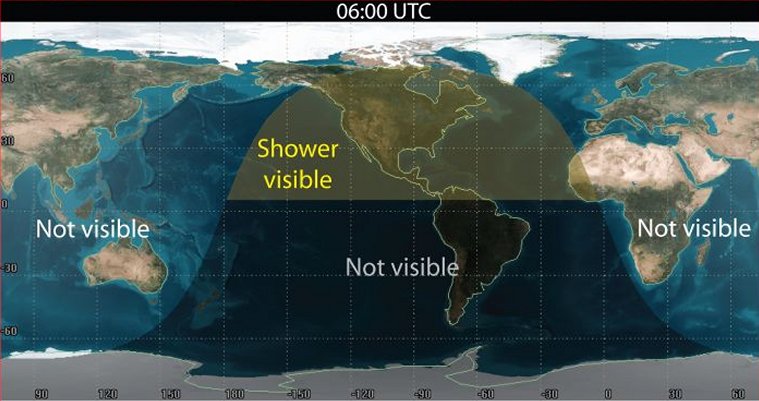
Peak of the shower will be between 1 a.m. and 3 a.m. CST
Sky-watchers all across North America are in for a real treat in the early morning hours of May 24 – there’s a brand new meteor shower that may light up the night sky. Scientists aren’t sure yet how many shooting stars people may see, but the May Camelopardalids meteor shower could be at a dazzling one-per-minute rate.
› Watch Live Coverage on Ustream
This is the first time Earth will directly cross the dusty trails left behind by a recently discovered comet named Comet 209P/LINEAR. Discovered in 2004, this comet’s path has been slowly altered by Jupiter’s gravity over the last 200 years and the leftover dust will now cross Earth’s path. That’s good news for those in North America who – weather permitting – will have a front-row seat to see Mother Nature’s celestial display of fireworks. The meteors will appear from the northern constellation Camelopardalis.
Astronomer Carl Hergenrother, a scientist at the University of Arizona, Tucson, working on a NASA-funded mission to an asteroid called the Origins Spectral Interpretation Resource Identification Security Regolith Explorer – or Osiris-Rex, said there is no danger to Earth. The particles in this dust trail are small, most about the size of grains of sand, and they will burn up as soon as they hit Earth’s atmosphere.
“What’s really nice about this particular comet [209P/Linear] is that we’re going right smack in the middle of these dust trails and the meteors are going to be pretty slow,” Hergenrother said. “They’re actually going to last maybe for a second or two. It’s going to look almost like slow moving fireworks instead of the usual shooting stars that we’re used to.”
The peak of the shower will be between 2 a.m. and 4 a.m. EDT, but Hergenrother said sky-watchers will still see meteors for several hours before and after those times. The biggest advice he has for people is to find a dark, safe place to get cozy and watch the stars.
“Pick someplace where you can see as much of the sky as possible,” he said. “It really doesn’t matter where in the sky you’re looking, even though the meteors will be coming out of the north.”
He added that one great thing about meteor showers is that you don’t need any special equipment to enjoy the show. Just make sure to give your eyes time to adjust to the darkness.
Hergenrother has been studying Comet 209P/Linear for the past few months. He said the comet itself is about one to three miles long, and will make its closest approach to Earth on May 29 at a distance of 5 million miles. This comet is relatively faint, so don’t expect to see it without a sophisticated telescope.
There is still plenty more to learn about Comet 209P/Linear and what it was doing prior to its discovery in 2004. Like a forensic investigation, Hergenrother said scientists will use the brightness of these meteors combined with their distribution and what part of the sky they’re coming from to determine the size of the particles and what speed and when they came off the comet.
“Right before your eyes you’re seeing a grain of dust that was released from a comet hundreds of years ago that resided in that comet for billions of years,” Hergenrother said. “It may have even existed before the Earth existed, and there it is burning up right in front of you. So you’re watching a billions of years journey end right in front of your eyes.”
Hergenrother also has his eyes focused on another ancient piece of the solar system, an asteroid named Bennu.
In 2016, NASA will launch Osiris-Rex, which will travel to Bennu and return samples for study back on Earth in 2023. Asteroids are rocky debris left over from the creation of our solar system 4.5 billion years ago. Some asteroids have changed little over time and are treasure troves of information about the very beginnings of our solar system. They may even shed light on the sources of organic materials that made life possible on Earth. Osiris-Rex will be the first U.S. mission to return samples from an asteroid.
Meanwhile, if you miss the Memorial Day weekend meteor shower don’t worry. There are two more major meteor showers coming up – the Perseids happening Aug. 12-13 and the Geminids on Dec. 13-14. There are also several smaller showers throughout the year.
On the night of May 23 into the early morning hours of May 24, NASA meteor expert Bill Cooke of NASA’s Marshall Space Flight Center in Huntsville, Alabama, will host a live web chat from 11 p.m. to 3 a.m. EDT. To access the chat, log in and ask questions, go to:
